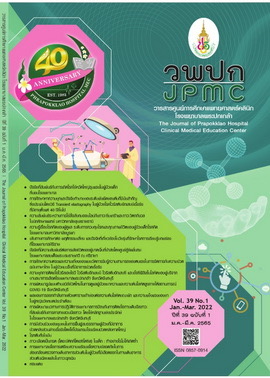Prevalence and Predicting Factors of Significant Liver Fibrosis Evaluated by Transient Elastography in Patients with Chronic Hepatitis B Aged 40 Years or More
Main Article Content
Abstract
BACKGROUND: Chronic hepatitis B ensues chronic liver inflammation resulting in liver fibrosis, liver cirrhosis, and hepatocellular carcinoma. Detection of the early stages of liver fibrosis by non-invasive methods; such as, transient elastography is the key recommendation under the current guidelines, especially in patients aged 40 years or more. However, the prevalence and predicting factors of significant liver fibrosis in Thai patients aged 40 years or more have not yet been studied.
OBJECTIVES: To study the prevalence and predicting factors of significant liver fibrosis evaluated by transient elastography in patients with chronic hepatitis B aged 40 years or more.
METHODS: This cross-sectional study consisted of 150 patients with chronic hepatitis B aged 40 years or more who were evaluated with liver fibrosis by transient elastography at the Special Investigation Unit, Department of Internal Medicine, Phrapokklao Hospital, Chanthaburi Province, Thailand during January 2017-August 2020. The demographic data, laboratory data, hepatitis B profile data, as well as results from transient elastography were collected for analysis. Significant liver fibrosis was determined as ≥7 Kilopascal.
RESULTS: The results showed that 47.3% of patients with chronic hepatitis B aged 40 years or more who had been evaluated by transient elastography had the prevalence of significant liver fibrosis. Significant liver fibrosis had a statistically significant association with sex, positive HBeAg, negative anti-HBe, serum HBV-DNA≥20,000 IU/mL, and the active disease group. In comparison to non-significant liver fibrosis, the group with significant liver fibrosis had a statistically significant lower mean of the platelet and albumin level and a higher mean of INR, Globulin, Bilirubin, AST, ALT, and ALP, as well as higher median of serum HBV-DNA. Additionally, the multivariate logistic regression analysis showed the platelets <150,000/mm3 (OR 7.35; 95%CI 1.64-33.0; p=0.01) and INR>1.1 (OR 5.77; 95%CI 1.53-21.78; p=0.01) were predicting factors for significant liver fibrosis.
CONCLUSION: The prevalence of significant liver fibrosis evaluated by transient elastography in patients with chronic hepatitis B aged 40 years or more was nearly half of the total number of patients. The predicting factors for significant liver fibrosis were platelets <150,000/mm3 and INR>1.1. Patients with these predictors should be evaluated for liver fibrosis by transient elastography for an optimal follow-up or initiation of treatment.
Thaiclinicaltrials.org number, TCTR 20220126005
Article Details

This work is licensed under a Creative Commons Attribution-NonCommercial-NoDerivatives 4.0 International License.
References
Sarin SK, Kumar M, Lau GK, Abbas Z, Chan HL, Chen CJ, et al. Asian-Pacific clinical practice guidelines on the management of hepatitis B: a 2015 update. Hepatol Int 2016;10:1-98.
Yimnoi P, Posuwan N, Wanlapakorn N, Tangkijvanich P, Theamboonlers A, Vongpunsawad S, et al. A molecular epidemiological study of the hepatitis B virus in Thailand after 22 years of universal immunization. J Med Virol 2016;88:664-73.
European Association for the Study of the Liver. Electronic address:easloffice@easloffice.eu; European Association for the Study of the Liver. EASL 2017 clinical practice guidelines on the management of hepatitis B virusinfection. J Hepatol 2017;67:370-98.
Thai Association for the Study of the Liver.Thailand practice guideline for management of chronic hepatitis B and C 2015. Nonthaburi: Parbpim; 2015.
Terrault NA, Lok ASF, McMahon BJ, Chang KM, Hwang JP, Jonas MM, et al. Update on prevention, diagnosis, and treatment of chronic hepatitis B: AASLD 2018 hepatitis B guidance. Hepatology 2018;67:1560-99.
Castera L, Forns X, Alberti A. Non-invasive evaluation of liver fibrosis using transient elastography. J Hepatol 2008;48:835-47.
Chu CM, Liaw YF. Chronic hepatitis B virus infection acquired in childhood:special emphasis on prognostic and therapeutic implication of delayed HBeAg seroconversion. J Viral Hepat 2007;14:147-52.
Qi X, An M, Wu T, Jiang D, Peng M, Wang W,et al. Transient elastography for significant liver fibrosis and cirrhosis in chronic hepatitis B: A meta-analysis. Can J Gastroenterol Hepatol [Internet]. 2018[cited 2021 Apr 21];2018:3406789. Available from https://downloads.hindawi.com/journals/cjgh/2018/3406789.pdf
Sirinawasatien A, Techasirioangkun T, Thongsri S. Prevalence and determinants of significant liver fibrosis by vibration-controlled transient elastography in Thai chronic hepatitis B patients. Int J Hepatol [Internet]. 2018[cited 2021 Apr 21];2018:4310102. Available from https://downloads.hindawi.com/journals/ijh/2018/4310102.pdf
Cristina SJL, Marta CM, Mercedes GS, Almudena PM, Álvaro HM, Luis VSJ,et al. Characterization and evaluation of liver fibrosis grade in patients with chronic hepatitis B virus infection and normal transaminases. Clin Mol Hepatol 2018;24:384-91.
Wong RJ, Le A, Nguyen MT, Trinh HN, Huynh A, Ly MT, et al. Significant hepatic fibrosis among treatment-naive chronic hepatitis B virus with increased hepatitis B virus DNA and normal alanine aminotransferase. Clin Gastroenterol Hepatol 2018;16:146-8.
Chen CJ, Yang HI, Su J, Jen CL, You SL, Lu SN, et al. Risk of hepatocellular carcinoma across a biological gradientof serum hepatitis B virus DNA level. JAMA 2006;295:65-73.
Rockey DC, Caldwell SH, Goodman ZD, Nelson RC, Smith AD. Liver biopsy. Hepatology 2009;49:1017-44.

